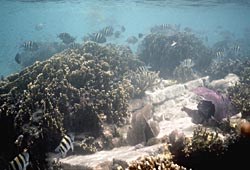Last updated: September 28, 2017
Article
Bird Key Shipwreck

Photos by and courtesy of National Park Service Submerged Resources Center
There is no specific information on the circumstances surrounding the wreck. All that is known is that the grounding and loss occurred sometime between 1857 and 1861. The earlier date is when the firebricks found on the wreck were manufactured. The later date is when the yellow construction bricks were produced for the Federal government. It is evident that the wreck was salvaged, as the engine and much of the machinery has been removed. The remains of the ship have been scatters by storms in the area. The wreck measures 107 feet long by 17 feet wide. It listing starboard with its bow facing the shore of the key. The composite hull is made up of a wrought iron frame with iron plates on the bottom and a wood exterior.
The Bird Key Wreck, located within Dry Tortugas National Park, is located in 4-9 ft. of water on the Bird Key bank, ½ a nautical mile southwest of Garden Key. Marine life is in abundance around the Bird Key wreck, especially fire coral.
Florida's Shipwrecks: 300 Years of Maritime History features a Teaching with Historic Places online lesson plan, The Spanish Treasure Fleets of 1715 and 1733: Disasters Strike at Sea. This lesson plan has been produced by the National Park Service's Teaching with Historic Places program, which offers a series of online classroom-ready lesson plans on registered historic places. To learn more, visit the Teaching with Historic Places home page.
